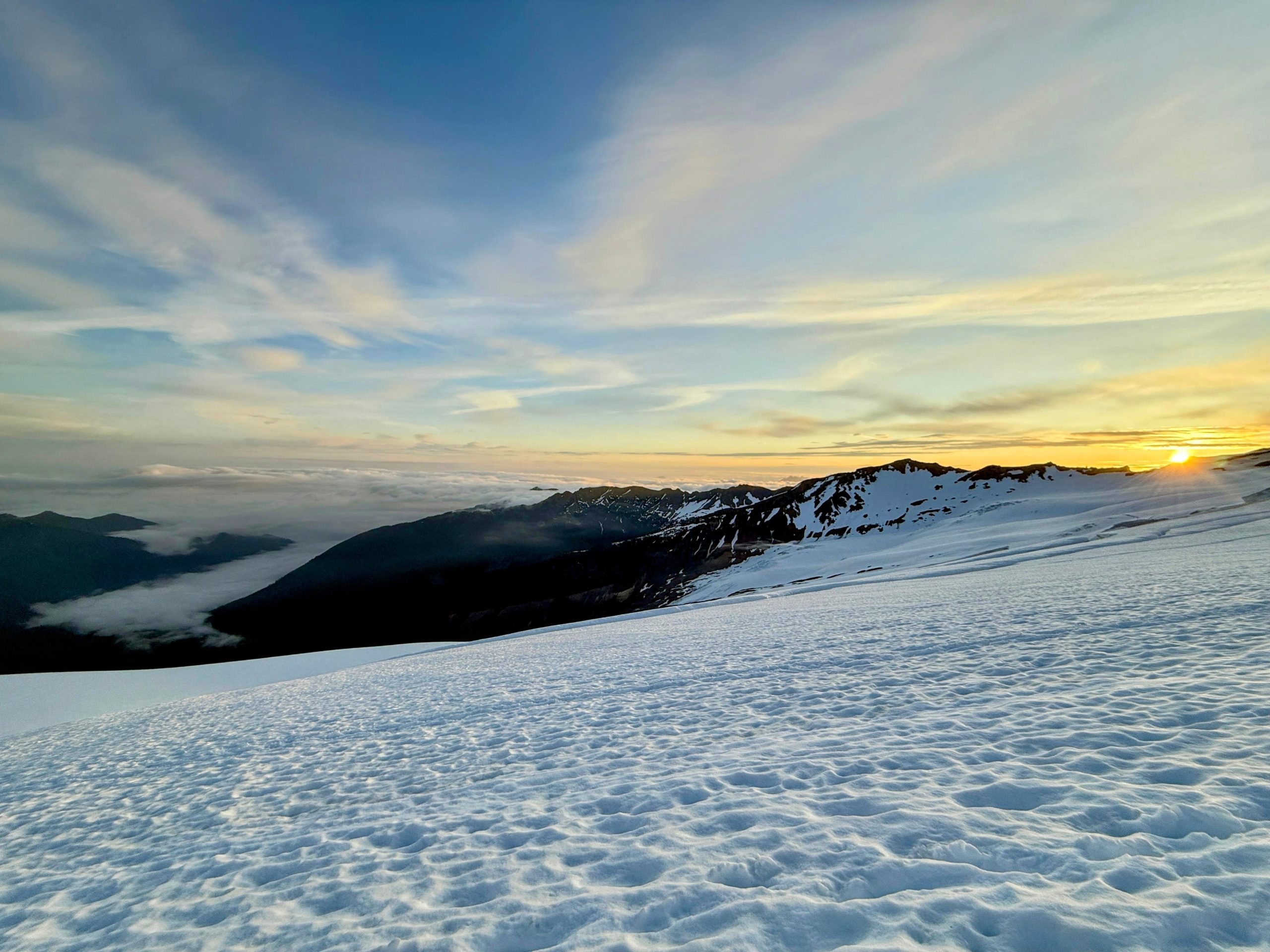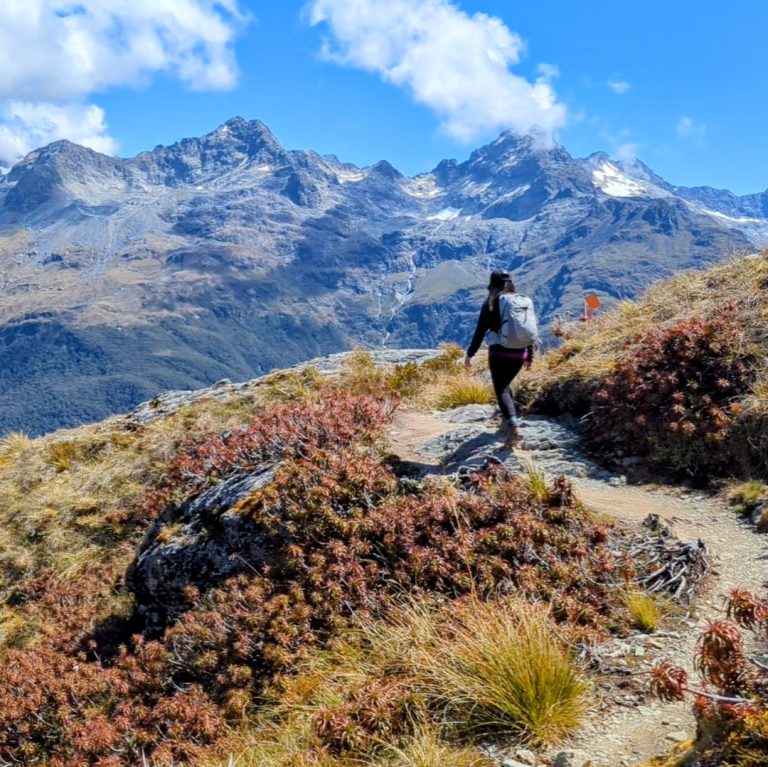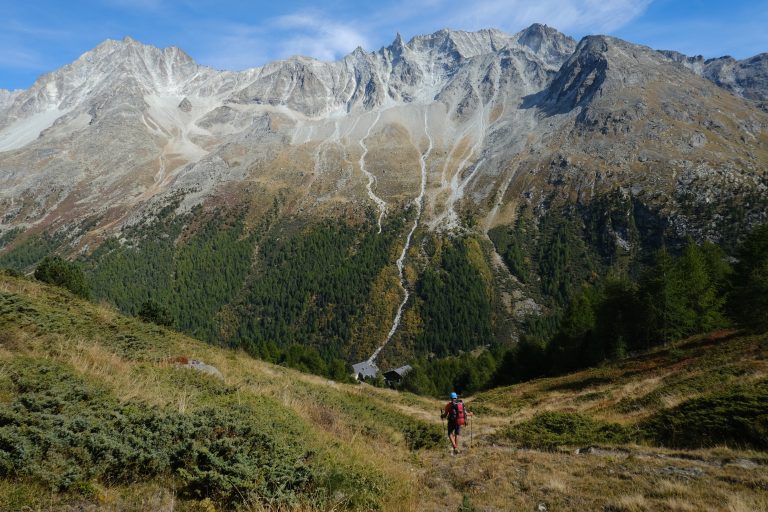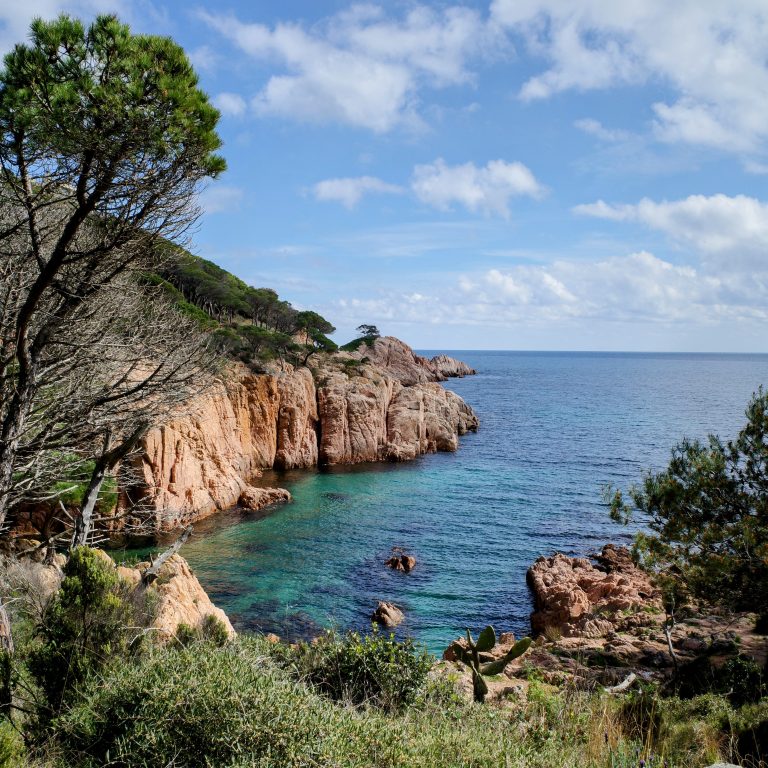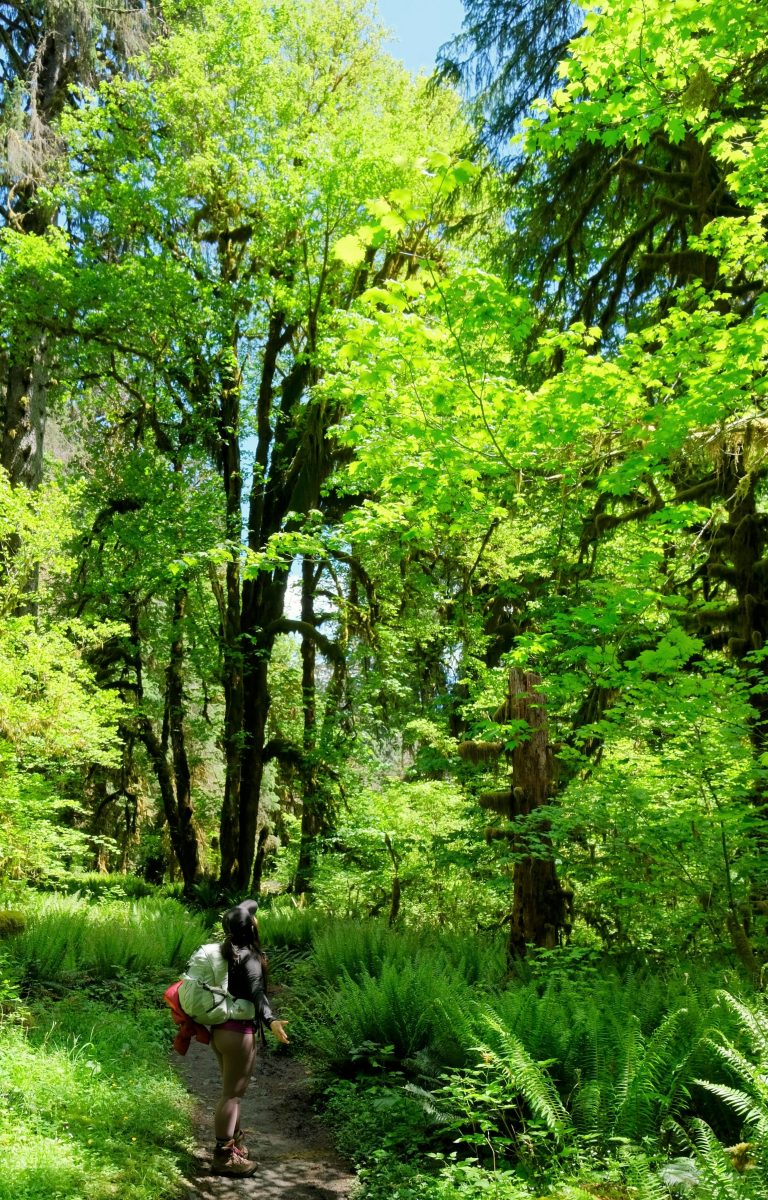Mt Baker Mountaineering Course: Honest Beginner Review
My honest review of American Alpine Institute’s Alpinism 1 course – or how I learned to stop worrying and love bear crawling in crampons
You know that moment when you’re doom-scrolling Instagram and suddenly see someone doing something so ridiculously cool that you immediately think “I MUST DO THAT”? That was me, staring at reels of folks summiting Mt. Baker in the North Cascades. The views looked straight out of a fantasy novel, and everyone looked like they were having the time of their lives dangling off ropes and strutting around in crampons.
There was just one tiny problem: I had absolutely zero mountaineering skills. Like, negative mountaineering skills. I wasn’t even sure what crampons were beyond “spiky shoe things.”
But my partner? She was ALL IN. “We’re signing up for a mountaineering course,” she declared with the confidence of someone who definitely hadn’t thought through what “6-day alpine course” actually meant. After some hemming and hawing (okay, a lot of hemming and hawing), we committed to American Alpine Institute’s Alpinism 1 course – an all-women’s adventure that would either make us into badass mountaineers or very cold, very tired people with excellent stories.
Spoiler alert: It was a little bit of both.
In this Mt Baker mountaineering course review, I’ll cover everything from gear rental chaos to crevasse rescue techniques, plus whether American Alpine Institute’s Alpinism 1 is worth it for beginners. If you’re considering a Mt Baker climbing course or wondering what mountaineering training actually involves, this honest trip report has you covered.
Day 0: Gear Tetris and Pre-Adventure Anxiety
We arrived in Bellingham looking like we were fleeing the country with two massive suitcases stuffed with every piece of outdoor gear we’d ever owned. The Hampton Inn Bellingham Airport became our staging ground for what I can only describe as “gear Tetris” – trying to figure out what the hell we actually needed versus what we thought we needed.
After one look at AAI’s comprehensive gear list, we gave up on packing entirely. Better to rent half the mountain and figure it out tomorrow, right?
Day 1: Meet the Badasses (And Try Not to Feel Inadequate)
Walking into AAI’s office at 7 AM felt like the first day of school, if school involved ice axes and the very real possibility of falling into a crevasse. Ten chairs arranged in a circle, two guides who looked like they could summit Everest before breakfast, and eight other women who all seemed to have their lives way more together than I did.
Our guides, Mia and Izzy, were living the van life dream and casually dropping wisdom about knots while I frantically scribbled notes like I was studying for finals. The other participants? A surgeon, a photographer, a college administrator, a gym owner/PT, a backcountry guide (naturally), an engineer, a travel OT – basically a lineup of humans who could probably MacGyver their way out of any mountain emergency while I’d be asking if anyone had a phone charger.
The gear rental process was… extensive. We needed almost everything:
- 0°F sleeping bags (because our 25°F bags were apparently for summer camping, not “sleeping on a glacier”)
- Crampons (the spiky shoe things!)
- Helmets (sobering reminder that rocks fall)
- Snow boots that made me feel like an astronaut
- Enough gear to outfit a small expedition
By the time we loaded into the vans, I was wondering if it was too late to fake a family emergency.
Mt. Erie: Where I Learned Ropes Don’t Lie
Our first stop was Mt. Erie for outdoor climbing practice. Hot day, nervous energy, and my first attempt at rappelling – which looked absolutely terrifying until I actually did it. Turns out, when you trust the system (and your guides know what they’re doing), leaning back into space is actually… fun?
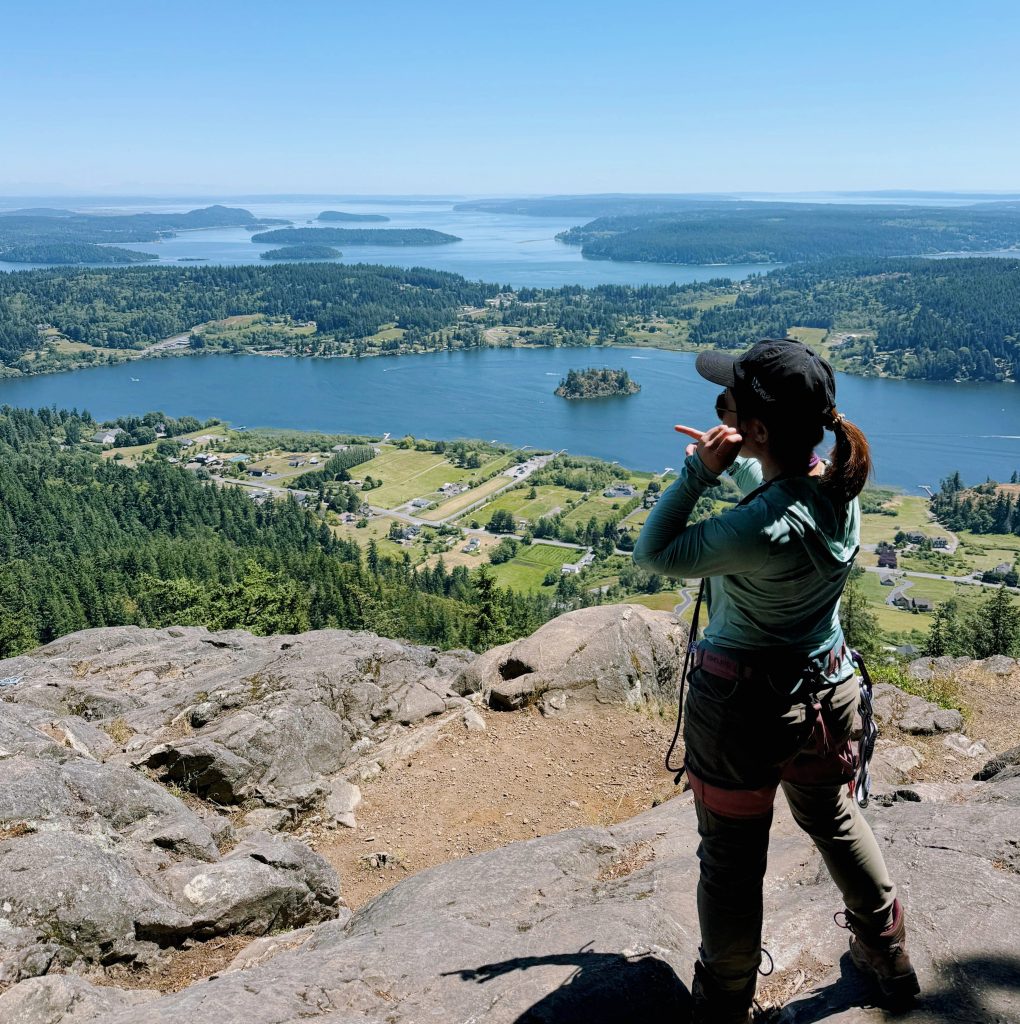
The outdoor climbing was a revelation. No colorful holds like at the gym – just rock and the satisfying puzzle of finding your own path up. I may have felt like Spider-Woman for exactly 30 seconds before my arms gave out, but those were a good 30 seconds.
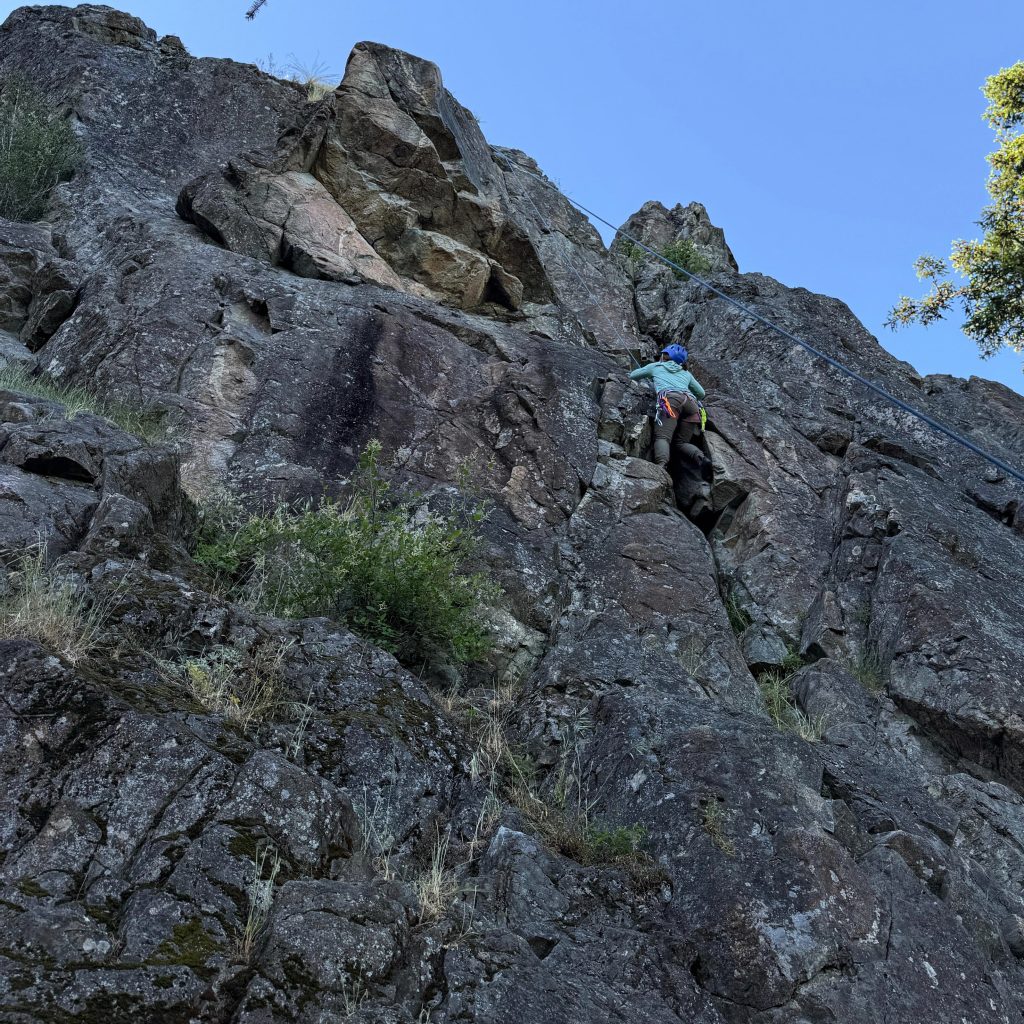
That evening at Bay View campsite, I learned my first crucial mountaineering lesson: tie your bear bags properly, or a very determined raccoon will absolutely ransack your beef jerky at 2 AM. (The hole in the bag was both impressive and embarrassing.)
Day 2: Welcome to Mt. Baker (AKA Snow World)
Hiking to our base camp on Mt. Baker’s Coleman Deming route was my introduction to “mountaineering pack weight.” These weren’t cute daypacks – these were full-scale, lung-crushing, quad-burning backpack monsters that required strategic lunging to get onto our backs.
The trail started gently enough, but three waterfall crossings with higher-than-usual water levels meant our guides had to scout safe crossing points while we followed like nervous ducklings.
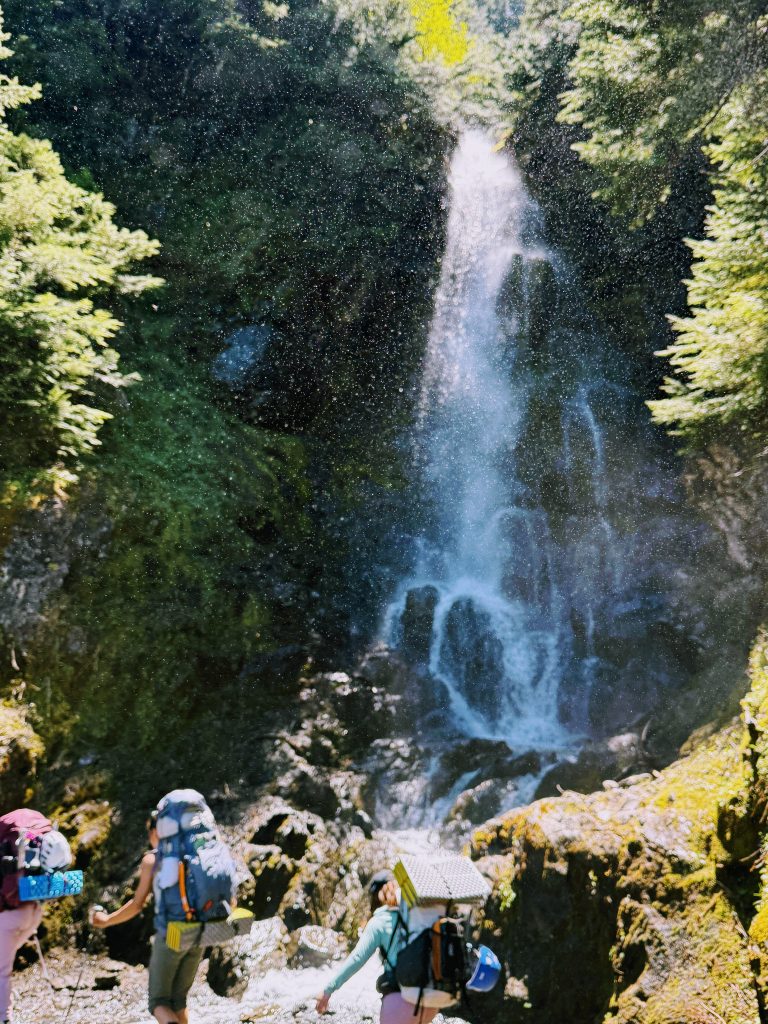
But the real culture shock? Setting up camp ON SNOW. Not near snow, not around snow—literally on a field of white where someone pointed and said, “This looks like a good spot!”
Our crash course in snow camping included:
- Reading wind direction (tent doors should NOT face the wind)
- Leveling a tent platform in snow (harder than it sounds)
- Building snow walls (much harder than it sounds)
- Digging a bathroom hole with steps
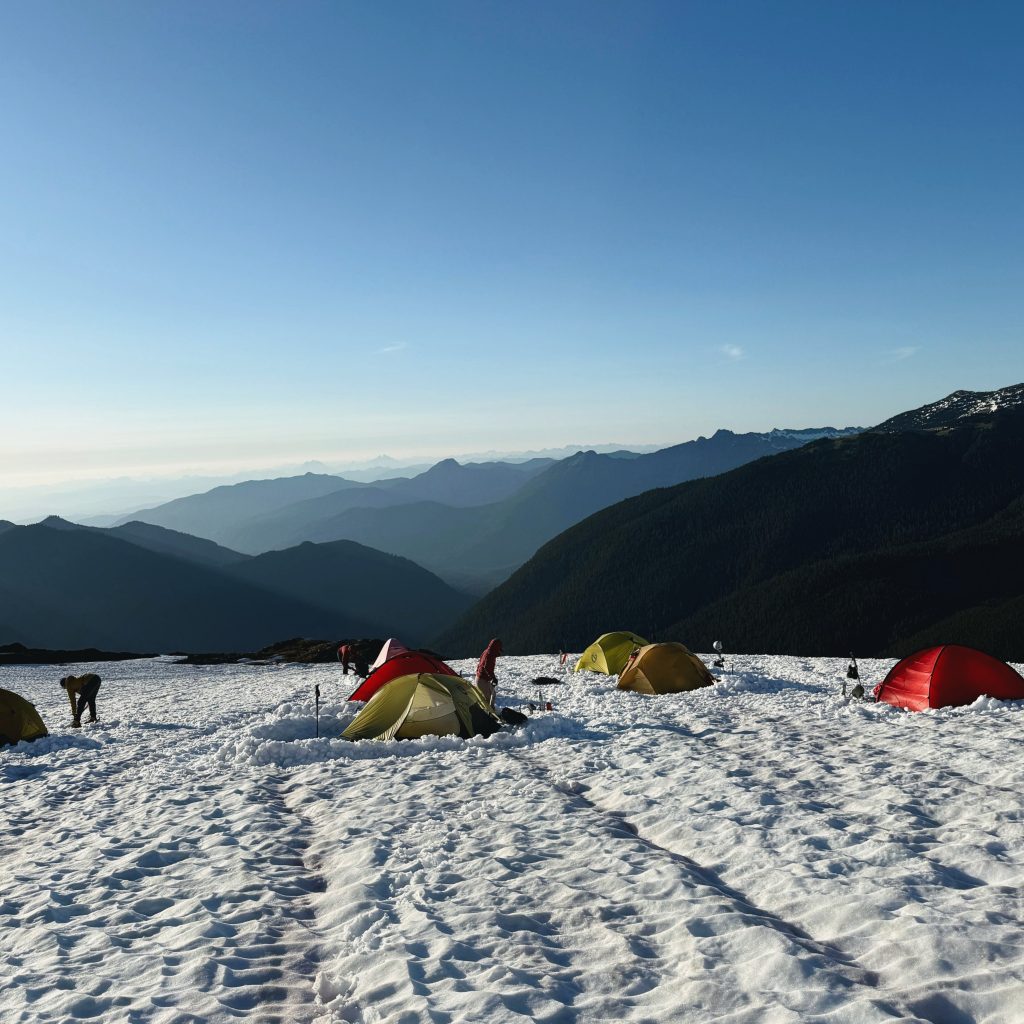
By dinner, we were exhausted, but sitting there watching the sunset paint Mt. Baker golden while mountain ranges stretched to infinity… yeah, I was starting to get it.
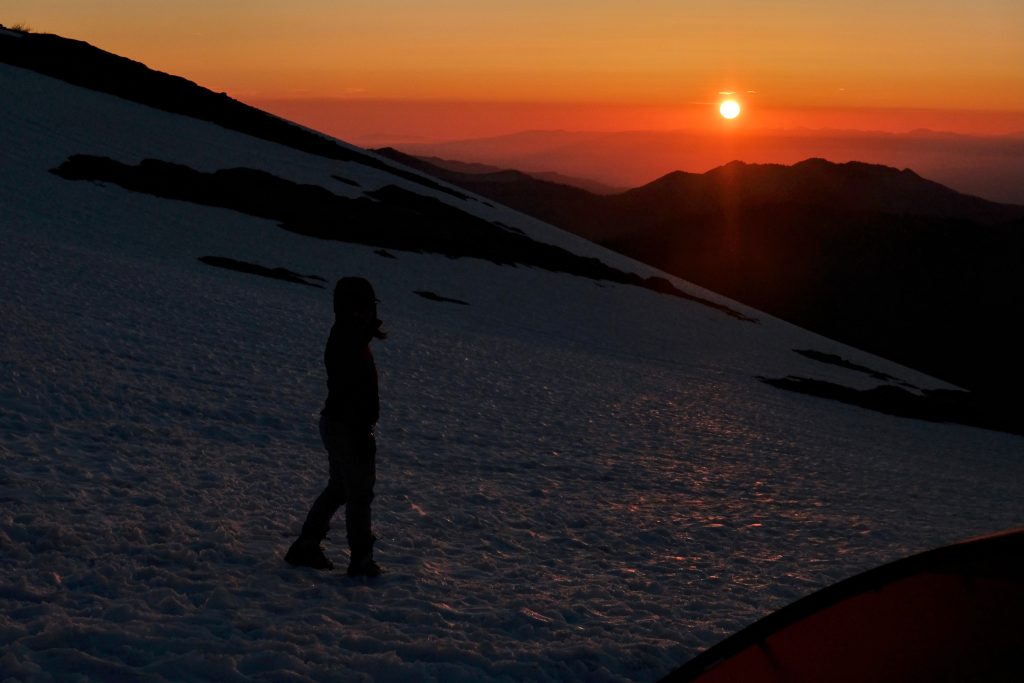
The only downside? The wind picked up after dark, and I spent half the night wondering if our snow walls were architectural masterpieces or future projectiles.
Day 3: Snow School, AKA Adult Playground Time
7 AM start time meant 6 AM wake-up for breakfast and the trek to our “water source” – roughly 100 feet away, down the slope from our campsite. Nothing wakes you up like scrambling back uphill with water jugs before coffee.
Our group was fascinatingly diverse – different ages, backgrounds, body types, experience levels. I’m barely 5 feet tall while Abby towered around 6 feet, but somehow we all ended up here together, united by our collective desire to learn how to not die on mountains.

Snow school day one was all about the fundamentals:
- Walking in snow boots: Kick, create platform, step. Simple in theory, surprisingly effective in practice.
- Ice axe technique: How to hold it, walk with it, and look moderately competent while doing so.
- Bear crawling: Because sometimes you need to crawl up a mountain, and there’s no shame in that.
- Self-arrest: The art of stopping yourself when gravity decides you’re going downhill whether you want to or not.
Self-arrest practice was the highlight – sliding down slopes on purpose while trying to stop yourself with an ice axe is exactly as fun as it sounds. We practiced with the pick facing different directions, using different hands (left-handed self-arrest felt like patting your head while rubbing your stomach), and in various positions.
Between lessons, we shared snacks, stories, and a lot of laughter. It felt like the world’s most badass playground day, with Mt. Baker as our backdrop and these incredible women as playmates.

Day 4: Crevasse Rescue, Or How to Feel Very Small
Day two of snow school started at 7 AM sharp with crampons – those spiky metal contraptions that make you feel like Spider-Woman but weigh approximately 500 pounds each. I’d tried them once in Patagonia but remembered nothing except that someone else put them on my feet.
This time, I had to figure it out myself. After Izzy’s patient re-explanation of the strapping system, I finally understood how they worked. Walking in them on steep snow was a revelation -suddenly I had grip! I was unstoppable! I was also clunky and uncomfortable, but mostly unstoppable.
Next up: rope team dynamics. The math is simple (rope distance = 10 feet minus number of people), but coordinating movement, switching ice axes between hands during turns, and not tripping over the rope while making Z-shaped traverses? That’s the tricky part.
Then came mechanical advantage systems – 1:1, 2:1, 3:1, 6:1 – basically how to use physics to haul things (or people) up mountains. Some teammates like Abby and Rose picked it up immediately, while I frantically took notes like I was cramming for an engineering exam.
But the real challenge? Crevasse rescue.
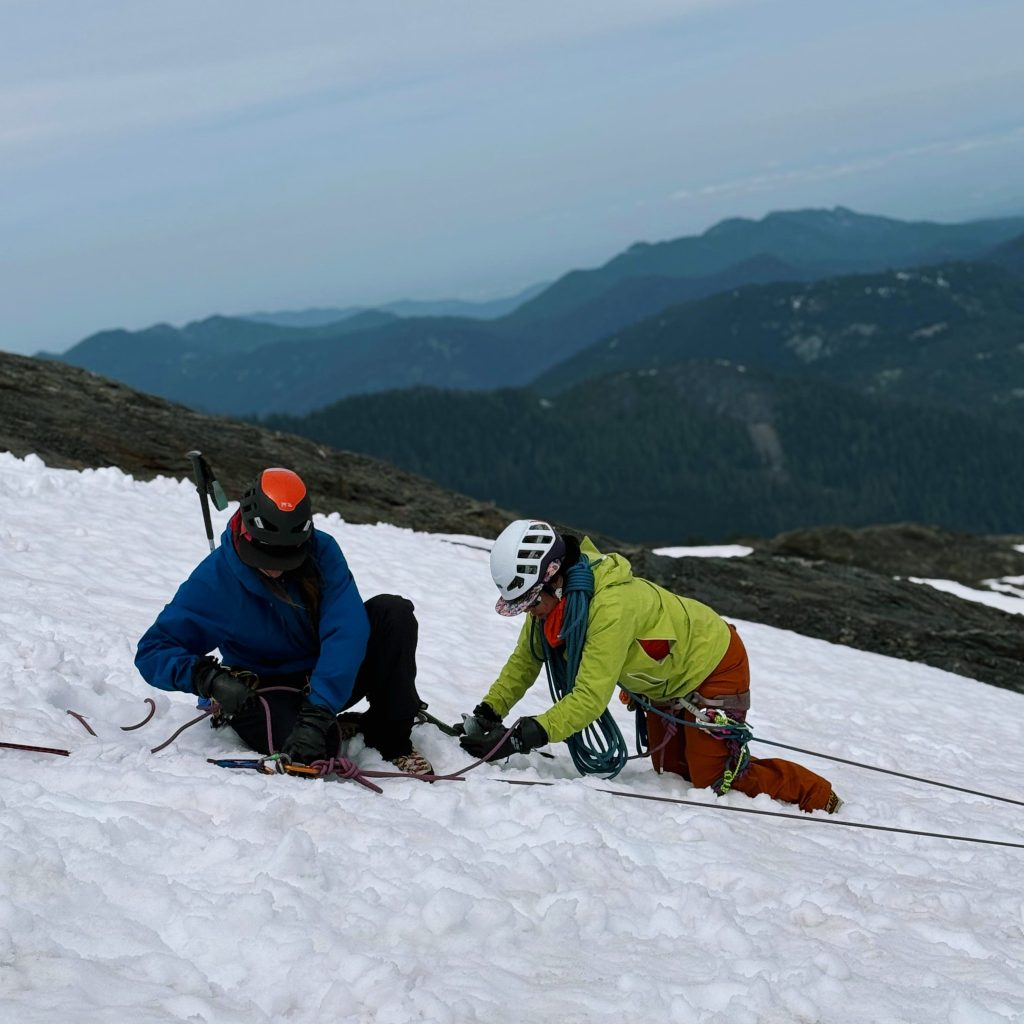
Picture this: You’re roped to your partner, they fall into a crack in the glacier, and suddenly you’re responsible for getting them out using nothing but rope, anchors, and pulleys. No pressure!
The process is absurdly complex: build anchors, set up mechanical advantage, establish safety systems, then haul your partner up while they try not to freeze to death in a crevasse. When it was my turn to rescue my partner, she got so bored waiting for me to set up the systems that she started taking photos of the mountain scenery.
“Did you abandon me?” she called up from her (fake) icy prison.
Reader, I had not abandoned her, but I was definitely questioning my life choices.
Meanwhile, our third guide Ama arrived – a former engineer turned trail runner turned mountain guide whose logical, detailed instructions made everything click (engineer solidarity is real, even when you’re dangling off a mountain).
During all this, someone spotted a massive sun halo – one of those perfect circles around the sun that usually means weather is coming. Izzy took one look and confirmed: “Storm’s on the way.”
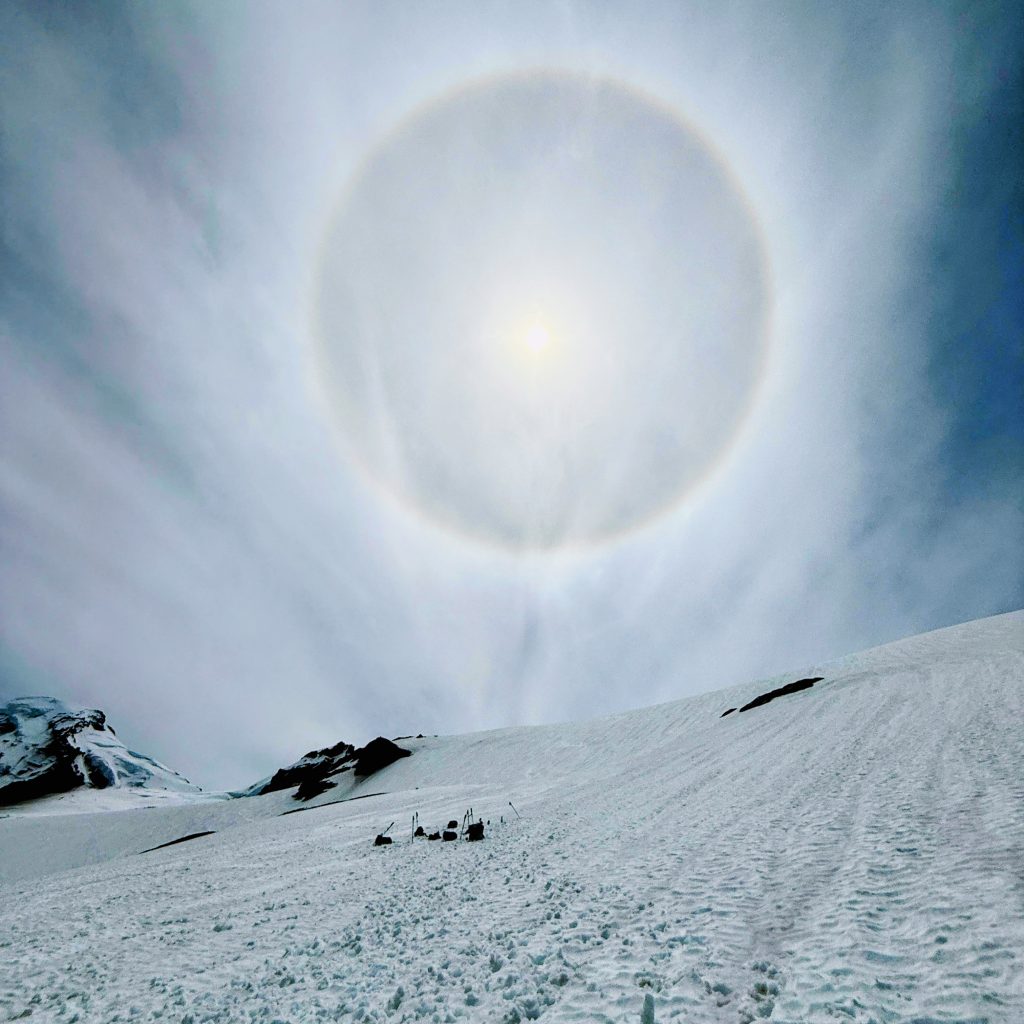
Great. Just in time for summit day.
Day 5: Summit Attempt, Or The Day Everything Went Sideways (Literally)
1:00 AM wake-up call. Because nothing says “fun adventure” quite like stumbling around in the dark making gear decisions that will affect the next 11 hours of your life.
The night before, our guides had strongly recommended wearing rain pants for summit day – the forecast showed potential rain, and getting wet while roped together on a slope would be dangerous. Once you’re moving as a rope team, there’s no good way to stop and put rain gear on.
So despite my rain pants being too small (listed as “optional” on the gear list, so I’d grabbed whatever fit in my suitcase), I chose to wear them. This turned out to be a mistake of epic proportions, but it felt like the responsible mountaineering decision at 2:30 AM.
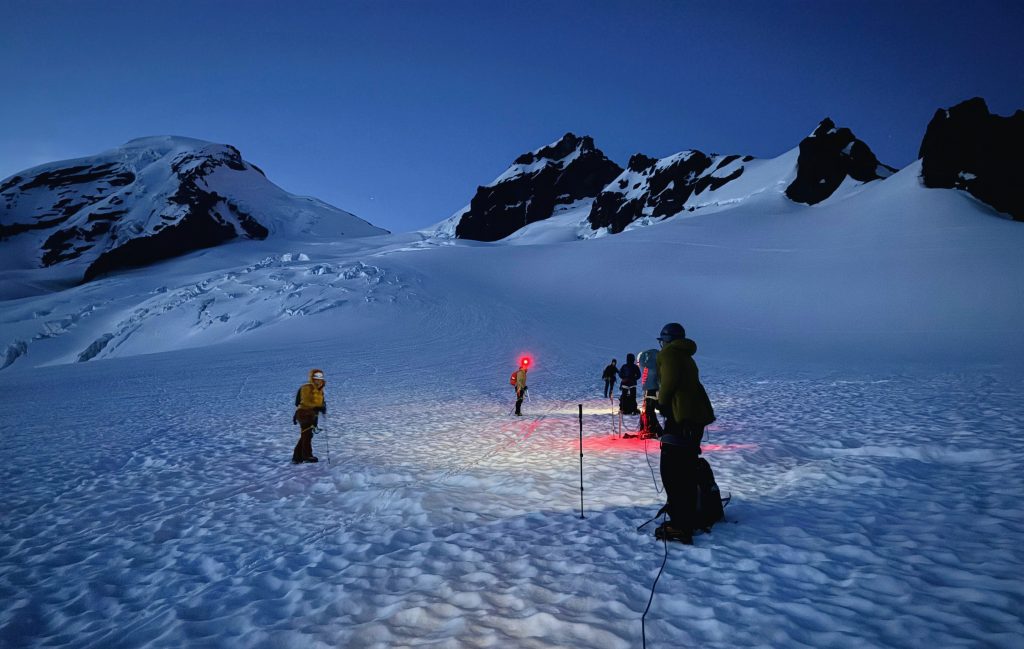
Within the first hour of climbing, I could barely lift my legs. My partner’s crampon fell off entirely and got rescued by another guide. Gabby, our third teammate, was moving faster than us, so she got traded to a different rope team.
Just us, Izzy, and the mountain. And my ridiculous rain pants.
As the sky lightened, we were treated to one of the most incredible sights I’ve ever seen: clouds rolling in like an ocean below us while the sun painted the peaks gold and orange. It would have been magical if I wasn’t in physical agony from my fashion choices.
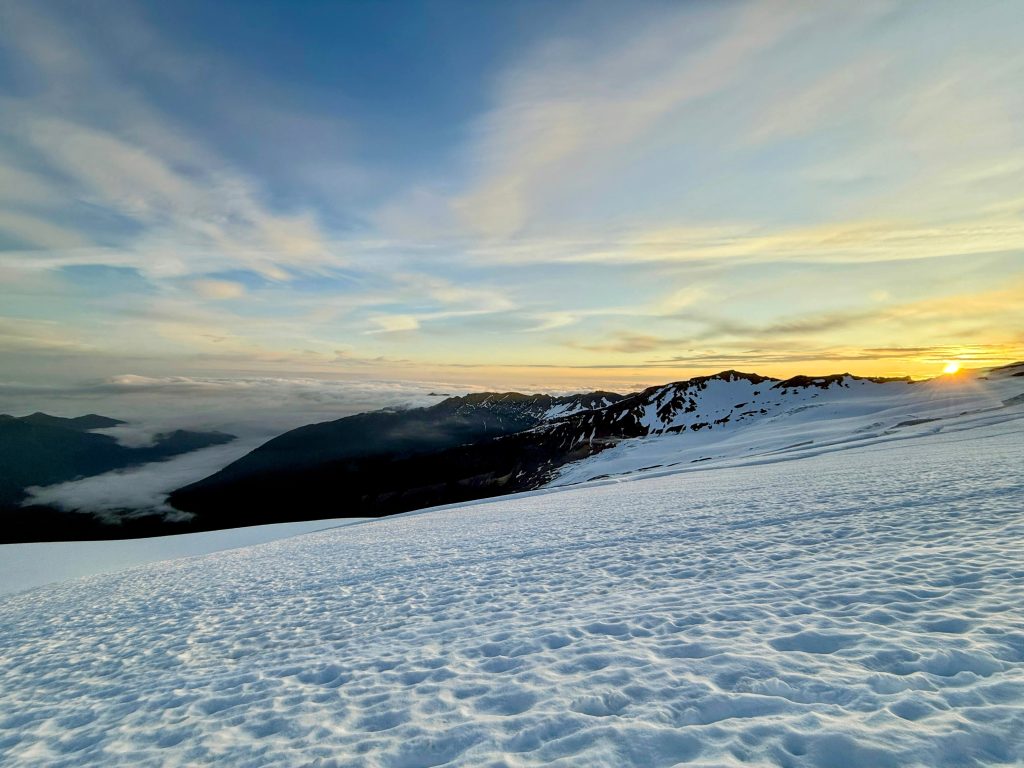
We pushed through the “danger zone” – a section where ice could fall from the glacier above – without stopping for 45 minutes straight. The moment we cleared it, I convinced Izzy to let me shed the rain pants of doom.
Immediate relief. Suddenly I could walk again! Maybe even summit!
We cramponed up rock sections (surprisingly non-slippery), crossed glacier fields, and reached a point where we could see Mt. Rainier in the distance.
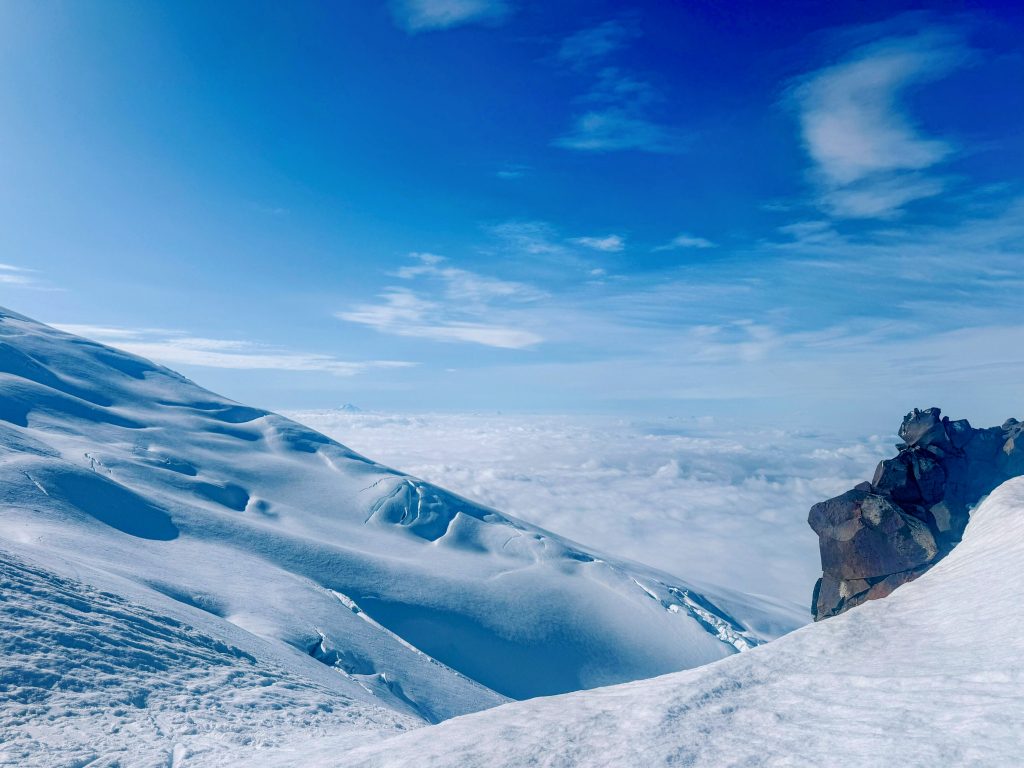
Then came the steepest slope yet – time for bear crawling with crampons and ice axes.
If you’ve ever wondered what it feels like to be the coolest person in the world, it’s bear crawling up a mountain in crampons. (The fact that this probably isn’t true doesn’t matter – for those 10 or fifteen minutes, I was unstoppable.)
We stopped about 1,200 feet below the summit. Could we have pushed higher? Maybe. Would it have been miserable getting down? Definitely. Sometimes knowing your limits is the most mountaineer thing you can do.
The descent involved bear crawling back down that same steep slope – but this time Izzy had set up an anchor system to catch us if we slipped (much more reassuring than free-form bear crawling). It was terrifying but fun, then speed-walking through the danger zone again (now with added melting and rockfall risk), and a bonus crevasse tour because why not cap off the day by staring into the beautiful, terrifying heart of a glacier?

Eleven hours later, we collapsed at our tent just as the other teams returned from their successful summits. Their celebration was infectious – pure joy and accomplishment that reminded me why we do these ridiculous things in the first place.
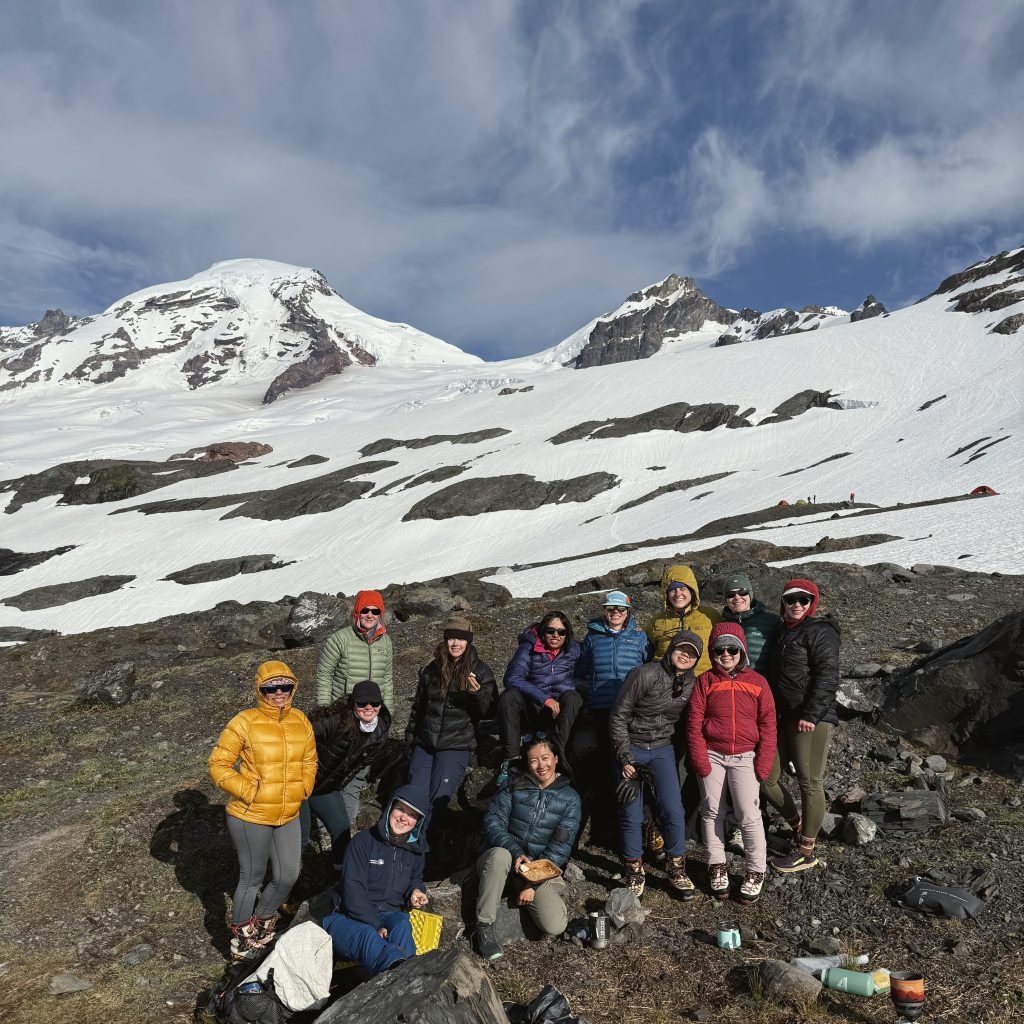
Day 6: Descent and Re-entry to Civilization
Breaking camp on snow is its own special challenge, especially when your “flat” tent site has become a hilltop thanks to differential melting. (Pro tip: snow camping means waking up on increasingly creative angles.)
Packing was… interesting. We’d eaten all our food but underestimated the volume of our wag bags (mountaineering glamour at its finest). Somehow everything fit, we left no trace, and we practically skipped down the trail.
Back at the trailhead, everyone was giddy with accomplishment and exhaustion. We made one final stop at our favorite café for burritos, coffee, and flushing toilets – civilization’s greatest hits.
The Aftermath: What I Actually Learned
Back at the hotel, I shampooed my hair twice and spent the evening in slippers because my feet had transformed into small balloons. Netflix felt like the height of luxury. Ramen tasted better than any five-star meal.
But here’s what really stuck with me: this course wasn’t just about learning to use an ice axe or tie knots (though I did learn those things). It was about being surrounded by incredible women doing hard things with grace, humor, and mutual support.
Hearing stories of triathlons, ultra-marathons, and ski expeditions didn’t make me feel inadequate – it expanded my sense of what was possible. These women didn’t just raise the ceiling; they blew the roof off entirely.
Did I summit Mt. Baker? Nope. Did I learn to arrest a fall, rescue someone from a crevasse, and camp on a glacier? Absolutely. Did I discover that I want to try outdoor climbing, heavy backpacking, and maybe even another mountaineering course?
You bet.
Sometimes the best adventures are the ones that scare you a little, teach you a lot, and leave you planning the next impossible thing. Mt. Baker didn’t break me – it just showed me how much stronger I could be.
And hey, at least I know how to tie a proper bear bag now. That raccoon doesn’t stand a chance next time.
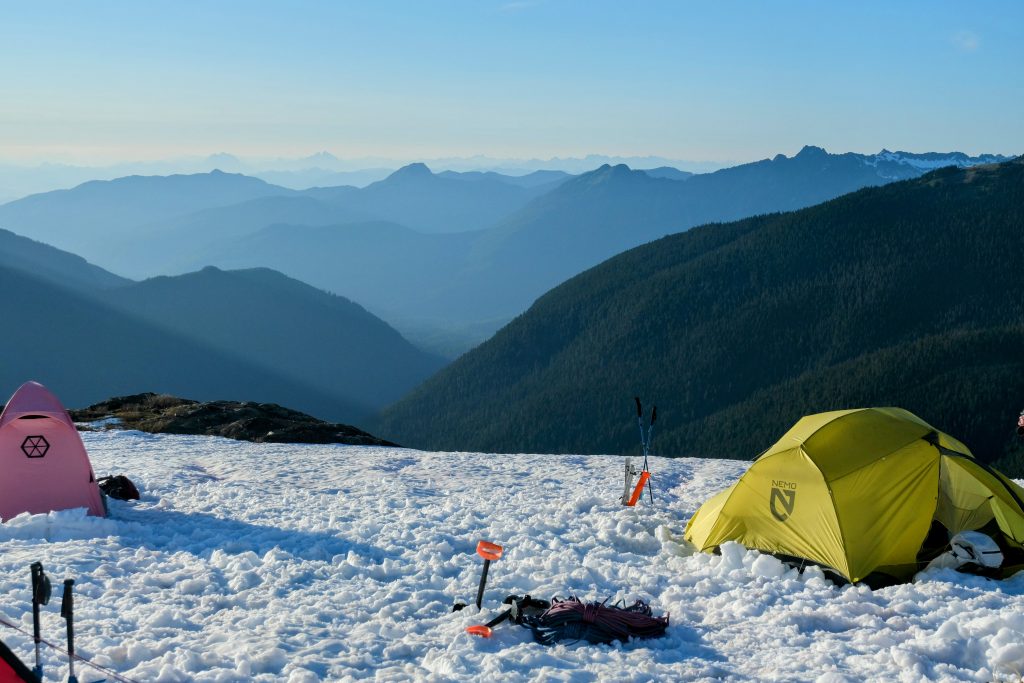
Want more questionable life choices disguised as adventure travel? Follow along for trip reports that are 50% useful information, 50% self-deprecating humor, and 100% honest about when things go sideways (which is often).
